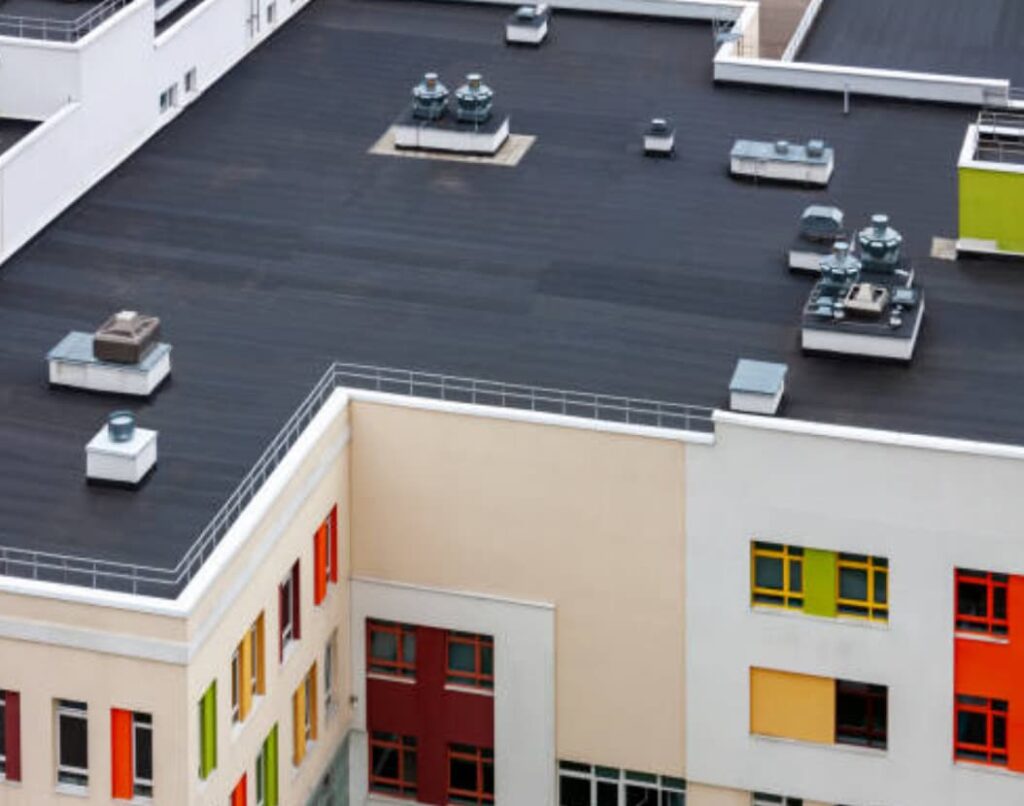Flat Roof Problems You Need to Know About
From the outset, a building’s roof is critical to its overall integrity. Flat roofs present a multitude of advantages, such as greater accessibility and flexibility in design. They are budget-friendly options, installation is relatively easy, and are also energy efficient depending on the roofing material used. However, there are a few flat roof problems you need to know about.

Due to their non-sloped nature, they come with a unique set of problems that can quickly become costly if left unchecked. Physical and mechanical failure, age and poor maintenance, as well as weather conditions, can all contribute to the deterioration of the roof. Common flat roof problems include:
1. Ponding Water:
Flat roofs are constructed with a slight slope that takes water from the center of the roof to the edges. If this gradient is not designed correctly, the slope may not have a sufficient angle for the water to run off. Standing water can accumulate on the roof’s surface and pool in low spots or depressions. The weight of this water can become too great for the structure to bear, leading to the deterioration of the membrane and eventually causing leaks.
Ponding water enables the growth of algae, moss and lichen, which can reduce the UV protection of the roof and cause premature aging.
2. Leaks:
Leaks are a common problem on apartment flat roofs, especially if the roof was not installed correctly or experienced damage due to wear and tear. Common sources of leaks are:
- Punctures
- Seams
- improperly installed flashings
- Cracks in the membrane
A flat roof typically comprises several separate membranes that are sealed together to form one continuous membrane. The seams can be especially vulnerable spots for leaks. Roofing materials tend to expand and contract with changing temperatures and weather. With time, the continued contraction and expansion of the membrane can cause seams to separate, opening them up to water intrusion.
3. Blistering and Cracking:
Blistering occurs when the roofing membrane becomes separated from the layers of insulation and decking underneath, creating air pockets in between. It worsens when the sun’s UV rays beat down on the roof, causing the air pockets to expand and create raised blisters or bubbles. Alligatoring is a type of cracking that appears like alligator or fish scale shapes on the roof’s surface. This usually happens when the roofing material reaches the end of its life span and can no longer handle temperature changes.

4. Shrinkage:
Shrinkage is less common but equally damaging problem. It occurs on roofs made from rubber, plastic or tar-based materials that shrink as they age. Shrinkage causes the seams between pieces to delaminate and pull apart, leading to leaks. Sometimes the membranes will show cracking patterns which are a sign of shrinkage problems.
5. Debris and Dirt Buildup:
Unlike sloped roofs, flat roofs lack the steepness to shed dirt and debris easily. In the absence of regular maintenance, leaves, branches, dirt and other debris can build up over time. This can lead to blockage of water drainage channels, increase the risk of damage from strong winds, and cause water ponding on the roof surface.
Large piles of debris can also provide a safe haven for pests and rodents to breed, leading to additional problems. In addition, they hold moisture, which can accelerate the deterioration of roofing materials. Regular maintenance and cleaning of flat roofs can help to minimize these problems and ensure they remain in good. You can remove the debris by pressure washing or blowing them off.
6. Punctures and Tears:
Flat roof systems are prone to punctures, tears and cuts due to foot traffic or sharp objects such as branches and stones. The roof can also experience damage due to heavy snowfall or severe weather conditions. Any damage to the membrane can quickly lead to water infiltration and costly repairs.
Property owners can limit access to the roofs or incorporate walk paths and safe areas for foot traffic to minimize these types of problems. When necessary, pea gravel or rubber matting can be used to protect the roof membrane.
7. UV Damage:
The sun’s powerful ultraviolet rays can wreak havoc on a flat roof, accelerating the breakdown of roofing materials and membranes. Over time, the UV rays weaken the membranes and coatings causing them to become brittle and crack. To protect against this damage, apply a layer of elastomeric roof coating that includes a UV inhibitor. The coatings also help to reflect the sun’s heat, reducing energy costs and helping to keep the building cooler.
8. Wind Uplift:
If a shingle or two is blown off a sloped roof, the rest of the shingles stay in place and the damage is minimal. On a flat roof, however, even a small gust of wind can cause a much larger area of damage. Wind uplift occurs when strong winds create an air pocket underneath the roofing material and literally lift it off its substrate. Usually, our team at CD Roofing installs gravel or ballast to counter wind uplift effects and strong adhesives and fasteners to hold the roofing membrane in place.
9. Thermal Movement:
Thermal movement occurs when the roofing material expands and contracts in response to temperature changes. The constant expansion and contraction can stress the roofing membrane, leading to cracking, wrinkling, or tearing. In addition, the movement can cause fasteners and flashings to delaminate and let water in. Proper cushioning materials can help to absorb the shock of thermal expansion and contraction and provide a buffer between the membrane and fasteners.
Final Thoughts
Physical failure can be prevented with regular maintenance and inspections, but it starts with proper flat roof installation. Ensuring that the base materials are correctly installed and the correct type of waterproofing membrane, fasteners, flashings and sealants are used is essential to the longevity of a flat roof.
When it comes to flat roof problems, prevention is key and understanding the potential issues is a great start. With regular inspection and maintenance, these problems can be minimized and your flat roof can remain in good condition.
